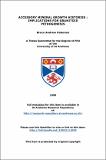Files in this item
Accessory mineral growth histories : implications for granitoid petrogenesis
Item metadata
| dc.contributor.author | Paterson, Bruce Andrew | |
| dc.coverage.spatial | 224p, 24p of plates | en_US |
| dc.date.accessioned | 2017-06-22T11:56:34Z | |
| dc.date.available | 2017-06-22T11:56:34Z | |
| dc.date.issued | 1990 | |
| dc.identifier | uk.bl.ethos.312391 | |
| dc.identifier.uri | https://hdl.handle.net/10023/11059 | |
| dc.description.abstract | Accessory minerals in granitoids are major repositories of several geochemically-important trace elements and isotopes and in order to quantify the influence that they have over granitoid petrogenesis it is necessary to characterize fully their behaviour. In particular it is necessary to understand accessory mineral/melt partitioning of trace elements and within grain elemental diffusivities, the latter is of relevance when assessing the state of isotopic equilibration between a refractory accessory phase and a contacting melt. In this study the backscattered electron (BSE) imaging technique, coupled with quantitative electron microprobe analysis indicate that granitoid zircons and titanites (mainly taken from Caledonian intrusive complexes) are commonly compositionally zoned. The zoning textures observed in these minerals, namely crystal face-parallel zoning, non-planar compositional zoning (included here are subhedral and anhedral core structures) and compositional sector zoning, indicate that the kinetic factors of crystal growth, i.e. within magma elemental diffusion rates, crystal growth rates, interface kinetics and dissolution kinetics, are largely responsible for the patterns of compositional zoning that have been observed. This fording is in marked contrast to other studies which have assumed that kinetics are not important in crystallizing plutonic granitoid magmas. Accessory mineral growth histories have been studied in a few well constrained samples from the Caledonian-age Strontian Complex of NW Scotland. The zircons from the central intrusion of this composite pluton have abundant inherited cores. The cores contain a variety of zoning structures and have a wide range of composition, which are taken to indicate that the cores had a wide variety of ultimate sources. Titanites from both the outer and inner intrusions have compositional sector zoning and the range of composition shown by the titanites is largely due to this fact. In this pluton magma composition appears to have little influence on titanite chemistry. The REE abundances in both parts to the intrusion are largely controlled by the accessory phases and each of these phases have very different rock-normalised REE distribution patterns. These abundance patterns are dependent on the relative partition coefficients that each phase has for the REE, the accessory mineral assemblage present and the crystallization order of that assemblage. The zircons from the central acid member of the Strontian Complex, which are known to have substantial U-Pb inheritance were extracted and analysed for their Sm-Nd isotopic composition. The results apparently indicate that refractory zircons can also preserve their Sm-Nd isotopic composition, a phenomenon not previously reported. That is diffusion of Sm and Nd (and presumably the other REE) within refractory zircon at elevated temperatures appears to be sufficiently slow that complete isotopic equilibration between a zircon and a contacting melt may not always occur. Such disequilibrium potentially enables granitoid magma provenance to be studied with much greater resolution than hitherto possible. | en_US |
| dc.language.iso | en | en_US |
| dc.publisher | University of St Andrews | |
| dc.subject.lcc | QE462.G7 | |
| dc.subject.lcsh | Granite | en |
| dc.title | Accessory mineral growth histories : implications for granitoid petrogenesis | en_US |
| dc.type | Thesis | en_US |
| dc.contributor.sponsor | Natural Environment Research Council (NERC) | en_US |
| dc.type.qualificationlevel | Doctoral | en_US |
| dc.type.qualificationname | PhD Doctor of Philosophy | en_US |
| dc.publisher.institution | The University of St Andrews | en_US |
This item appears in the following Collection(s)
Items in the St Andrews Research Repository are protected by copyright, with all rights reserved, unless otherwise indicated.

